|
ALGUNOS DATOS LIMNOLÓGICOS DE CINCO CUERPOS
ACUÁTICOS DE YUCATÁN COMO BASE PARA EL DESARROLLO DE LA
ACUACULTURA
Trabajo recibido el 1º Junio de 1993 y aceptado para su
publicación el 20 de febrero de 1994
Alejandro Flores-Nava
Centro de Investigación y de Estudios
Avanzados del IPN, Apartado Postal 73-Cordemex, 97310 Mérida,
Yucatán, MÉXICO.
Se realizó un estudio preliminar de la
hidroquímica de cinco embalses representativos de la región
cárstica del estado de Yucatán, México. La
limnología de esta zona era prácticamente desconocida hasta el
presente estudio. La calidad del agua está caracterizada por elevado pH,
alcalinidad y dureza, lo cual es originado por la naturaleza calcárea
del suelo. El comportamiento de los parámetros fisicoquímicos del
agua muestra patrones cíclicos marcados en cuerpos de agua temporales y
tendencias más definidas y estables en cuerpos de agua alimentados por
el nivel freático. Los niveles de nitrato se presentan en general en
altas concentraciones y la relación nitrógeno/fósforo
indica defiencia en fósforo, lo cual es una limitante para la
productividad primaria en la mayoría de los embalses estudiados. La
estratificación presente en cenotes aislados resulta en capas
hipolímnéticas anóxicas, producción de amonio y
ácido sulfhídrico, características de sistemás
hipertróficos, lo cual en principio limita el potencial acuícola.
La calidad del agua encontrada en pozas de explotación de roca caliza es
apta para el desarrollo de la acuacultura en jaulas flotantes. De igual forma,
agropiscicultivos de temporal en cuerpos de agua intermitentes se ofrecen como
una estrategia adecuada para la producción acuacultural en la
región.
PALABRAS-CLAVE: Acuacultura,
cárstico, limnología, cenote.
Preliminary chemical and physical observations were
made for five, ponds, of a variety of types, in the karst region of Yucatan
state, Mexico. The limnology of this area was essentially unknown until the
present study. Water quality was in general characterized by high pH,
alkalinity, and hardness, derived from the calcarcous nature of the bedrock.
Depending on whether the water body is aquifer fed or relies on rainfall and
runoff for its water balance, the physicochemical parameters show defined
stable or cyclical patterns. Nitrate occurred at high concentrations, and the
nitrogen-tophosphorus ratios in most sites indicated phosphorus limitation for
primary production in these relatively lowproductivity ponds. Stratifi resulted
in an anoxic hypolinimion with production of ammonium and hydrogen sulphide.
Hydrochernical characteristics of hypertrophic ecosystem,9 were found in
isolated sinkholes thus restricting potential for aquaculture. Water quality in
gravel quarries ponds would allow for in situ aquaculture, especially if cages
were suspended in the epilimnion. Also, cyclical agriculture-aquaculture in
small seasonal ponds seems an appropriate strategy for fish production in the
region, making use of the available natural productivity.
KEY WORDS: Aquaculture, karst,
limnology, cenote.
The State of Yucatan is situated in southeastern Mexico on the northern part of the Yucatan Peninsula. It is a large projection of land bordered by the Gulf of Mexico and the Caribbean Sea (Fig. 1). Northern Yucatan is contains mainly horizontal tertiary formations, of limestone and other soluble rocks (Stringfield and LeGrand, 1974). This area, which covers a third of the peninsula, is an almost level karst plain. There are no surface streams and, due to the high permeability, rain infiltrates rapidly into aquifers. The limestone is pitted and scarred by solution depressions, hence the only natural water bodies found in the area are sinkholes, which are holes or depressions formed by sinking of the land surface where the underlying rock has been removed by constant dissolution imposed by water (Isphording, 1975). These sinkholes are locally known as ''cenotes" and were the only source of water for ancient Mayans. There are also a number of man-made ponds, resulting from excavations by building industries which remove limestone and gravel for civil works scattered across the northern plain. In southern Yucatan, the land rises gradually to a low hilly karst surface about 130 m above sea level, and in some parts of the Sierrita de Ticul Range (the only important orographic feature), elevations rise to about 280 m above sea level. This range separates two areas of sornewhat different topography. South of the line of hills, deep sinkholes are scarce. Instead, there are many broad, shallow depressions, known locally as "aguadas", which in some cases cover several hectares. These water bodies are filled with water during the rainy season (May through October both from drainage and rainfall, and infíltration is retarded by a surface layer of organically rich and less permeable soils. Major industries in the northern plain produce cement and gravel for building purposes. These industries base their operations on the excavation of large pits to below the water table, creating ponds which cannot be utilized for agriculture, because they have steep sides and are inaccessible to livestock. Sea fishing is one of the oldest economic activities in Yucatan, as a consequence of the great diversity and abundance of marine organisms found in the productive coastal waters (Arreguín et al., 1987). In contrast, freshwater fisheries and aquaculture are poorly developed, since Yucatan has always been regarded as being an area with fairly scarce freshwater resources, with limited potential for development. The aim of the present paper is to describie the overall hydrology, limnology and suitability for aquaculture of representative ponds in Yucatan. 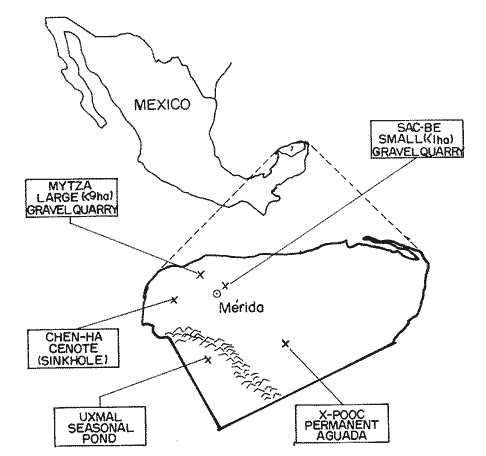 Figure 1. The Yucatan Peninsula, showing the State of Yucatan and the location of the study sites. METHODSA preliminary survey of freshwater ponds was made by map and fóllow-up land based surveys during 1986. An attempt was made to identify and include the main types of resources available in the State of Yucatan. On the basis of this survey, five water bodies were selected for further studies of water quality and hydrology, over the period 1986-1990: an open sinkhole; two limestone quarries, a clogged sinkhole and a seasonal pond. Each study site was visited for at least eight months to cover the rainy and dry seasons. During this period, sites were visited at least every month, for determination of physico-chemical parameters. Temperature, and dissolved oxygen were measured in situ using a YSI dissolved oxygen/temperature probe (YSI, Model 57). Turbidity and pH were also measured in situ using a Secchi disc and a portable Corning-1033 pHmeter. Total hardness EDTA-titration method), total alkalinity by titration with HCl 0.1N; total ammonia nitrogen (NH-3 + NH4) through colorimetry by formation of indofenol blue; nitrite using the colorimetric method with sulfanilamide; nitrate (reduction method with cadmium); dissolved reactive phosphorous (colorimetric method based on the formation of molibdate) and chlorophyll a(method proposed by SCOR-UNESCO), were determined on samples returned to laboratory for analysis, following procedures recommended by APHA (1985) and Strickland and Parsons (1972). Samples were, taken from midwater in the case of shallow water bodies (e.g. Sac-bé quarry and Uxmal seasonal pond), and both from surface (I m) and bottom layers (depending on depth) from aquifer-fed water bodíes (e.g. Mytza, Xpooc and Chen-Ha). Morphornetry of the sites was studied by means of direct measurements, using the procedures recommended by Hakanson (1981). Direct observations of the biota present were made in each site and major dominant species were recorded. One of the sites was fertilized with freshly-cut chopped grass Panicum virgatum, to assess the limnological changes induced by organic fertilization. Changes in phytoplankton and zooplankton communities in the system were recorded from samples collected prior to and after fertilization, with a 64m mesh size plankton net. Plankton samples were preserved in 5% formalin for posterior identification and relative abundance estimation. RESULTS AND DESCRIPTION OF THE SITESChen-Ha cenote: This water body is a typical small sinkhole situated 32 km south west of Mérida, capital of Yucatan state (Fig. 1). It is a circular open "cenote" with vertical porous walls (Fig. 2). It has a mean diameter of 46 m and a total surface area of 1,662 m² (Table 1). The only depth recorded due to the steepness of its walls, in a radius of approximately 700 m², was 110 m (Table 1). It is permanently fed by an aquifer and no changes in volume are detectable. 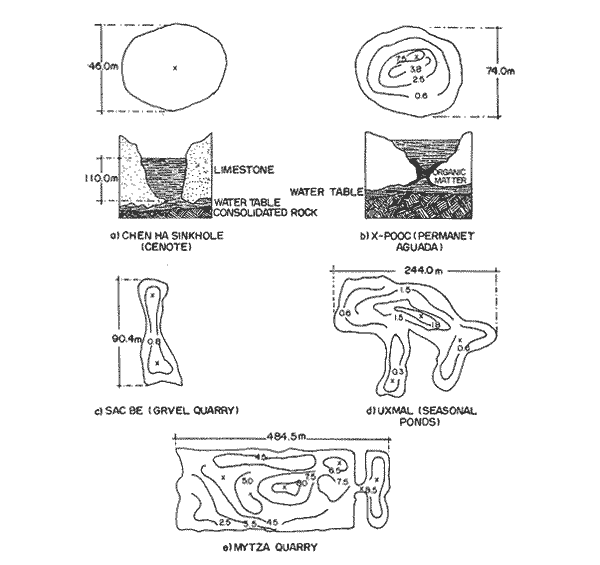 Figure 2. Contour maps and bathymetry of the study sites(not to scale). The survey, carried out between January and Sep- 1987, shows that Chen-Ha contained water with a high hardness and alkalinity (>300 and >100 mg/l CaCO3, respectively) with a somehow similar trend characterized by maxima between February and May and a gradual decrease afterwards. Levels of nitrate were fairly high especially at bottom water (2-3 mg/l), whereas nitrite and ammonia were low with undefined trends along the study period. Dis- reactive phosphorus was also fairly low (<0.02 mg/l) in both surface and bottom, layers. Disoxygen was high and temperature was fairly constant throughout the sampling period (Fig. 3). These results indicate a relatively unproductive, alkaline water with overall good water quality. Major representatives of the fauna of this water body were the native fish Cichlasoma urophthalmus and small fish or the genus Mollinesia sp. (Table 2).  Table 1. Summary of Morphometric Data of the Study Sites  TABLE 2. Endemic Fauna of the study sites X-Pooc aguada: Aguada is the local name given to certain types of water bodies present in the region. There are two types of "aguadas": 1) permanent aguadas which were originally sinkholes and are circular in shape but due to intense organic matter deposition, their wall have been sealed off thus isolating them from the aquifers [Flores-Nava et al., 1989 (Fig. 2)], usually deep (up to 15 m) these sinks are mostly concentrated in southeast Yucatan, and 2) seasonal aguadas, which are land depressions filled only temporarily with rain water each year. The larger permanent sínkholes are used as water sources for cattle and pigs; the more accessible seasonal aguadas are hardly used as water sources at all. X-Pooc is an example of the large permanent sinkholes (Fig. 1). It is a typical open sinkhole, with a mean diameter of 74 m and a mean depth of 3.70 m (Table 1). These aguadas are located in areas where the soil is organic, and as previously mansiones, organic run-off from cattle and pig manure, as well as decaying vegetation from the surrounding areas, results in a gradual clogging of the permeable walls of the sinkholes, thus sealing them off and restricting water circulation. This results in a water body with stagnant conditions (Stringfíeld and Le Grand, 1974; Flores-Nava et al., 1989). X-Pooc is permanently thermally stratified showing a thermocline at 2 m separating two másses of waterof different temperature and water quality. The euphotic zone is restricted to the fírst two meters where a dense phytoplankton community sustains small fish populations and imposes drastic diurnal changes especially of dissolved oxygen. Hypolim- waters are anoxic and levels of H2S limit fish production (Fig. 4). The aguada is also very rich in nutrients, with high concentrations of nitrogen and phosphorus compounds Chlorophyll a reaches a maximum of 300 mg o m-³ indicative of high priproductivity and eutrophic conditions. This high primary productivity, combined with thermal stratification, results in deoxygenation below the thermocline and very high levels of ammonia and dissolved reactive phosphorus. Hydrogen sulphide also reached levels as high as 4 mg ·1-¹. 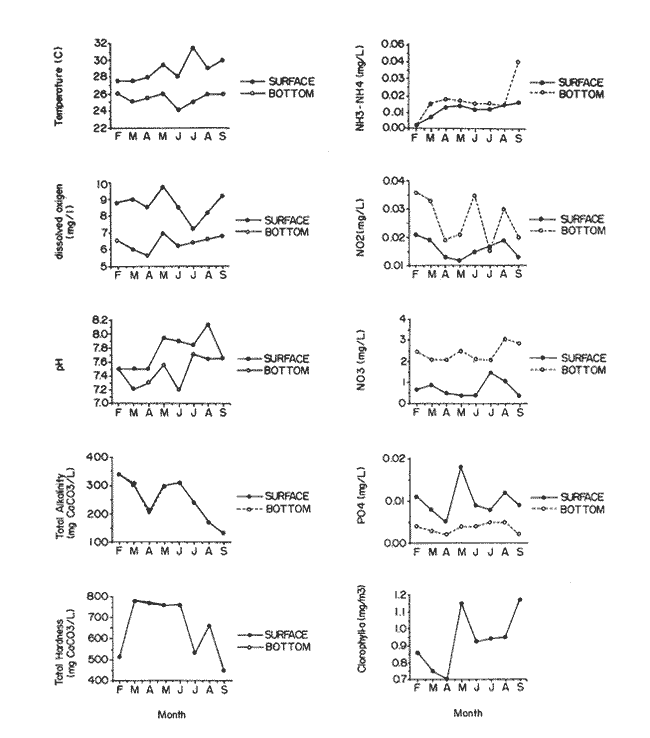 Figure 3. Temporal trends of physicocheinical parameters of Chen-Ha sinkhole. 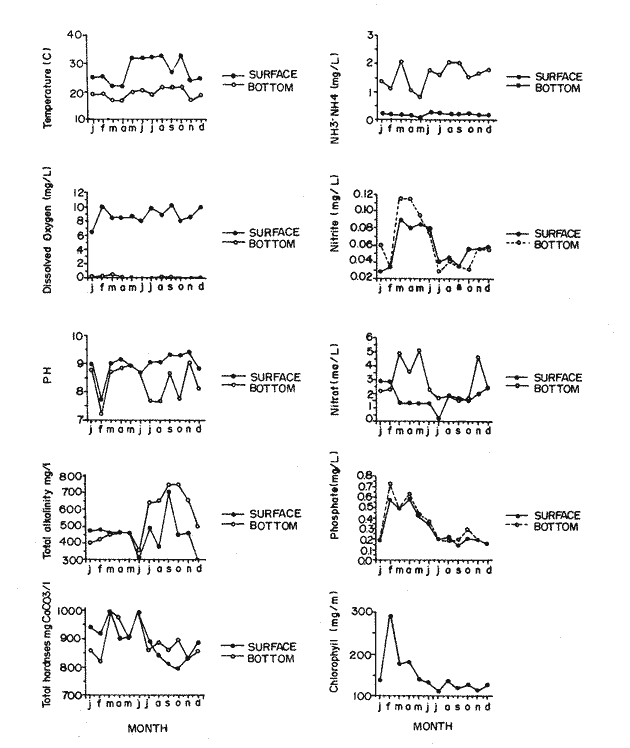 Figure 4. Water quality in X-pooc permanent aguada during the study period. The gastropod Pomacea paludosa and the "molly" Mollinesia veliufera are the only major species dwelling the surface layers of X-pooc (Table 2). Uxmal seasonal aguada: This seasonal water body has a somewhat rectangular shape. The minimum depth is 0.30 m and the maximum depth recorded at full capacity (end of July) is 1.80m (Table 1; Fig. 2). Seasonal aguadas differ from the permanent aguadas in several ways. As already mentioned, Southern Yucatan has thicker, organically rich soil. These conditions, combined with the higher rainfall south of the Sierrita de Ticul range, give rise to seasonal water filled-pools. These pools are known locally as "aguadas temporales" (seasonal pools). Such waterbodies have two mai n limnological phases; the dilution phase and the concentration phase. The former begins as the fírst rains come in early May, and is characterized by a sudden release of nutrients retained in the soil and the vegetation cover. Phosphorus and nitrogen are released into the aquatic environment being established which in tum trigger an increase in primary productivity and the subsequent links of the trophic chain (Arredondo, et al., 1982; Poffas, 1985). The concentration phase begins at the end of January, when the dry season increases evaporation, thus gradually reducing the volume of water in the aguada. Concentration of nutrients occurs in the remaining pools, which eventually dry out to leave nutrient-rich soils suitable for fastgrowing crops such as beans and chillis. This limnological cycle has been manipulated by the rural Mayan population to grow com, beans and other agricultural products during the dry season, and also to "store" organic fertile soil to improve other less suitable areas of the same region (Turner, 1980). The study of Uxmal seasonal pool illustrates the maín annual changes in water quality (Fig. 5). No thermal stratification was observed, probably because Uxmal is shallow (1.80 m maximum depth) and because it is on the surface of the ground, not sheltered by a sinkhole. Nitrogen and phosphorus increased in May and June after the start of the rainy season. Thereafter, the concentration of disolved reactive phosphorus and nitrate decreased as a result of dilution and/or losses. The concentration phase, as observed in several small pools, is characterized by an increase in dissolved reactive phosphorus and nitrate. Dissolved oxygen levels were similar throughout the water column as a result of mixing, and were lowest during early filling, as a result of decomposition of organic matter, but subsequently increased. By December, these pools start to dry out and nutrients concentrate and are finally retained in the soil. This allows a vegetátion cover to develop thus using up and retaining nutrients until the next rainy season. 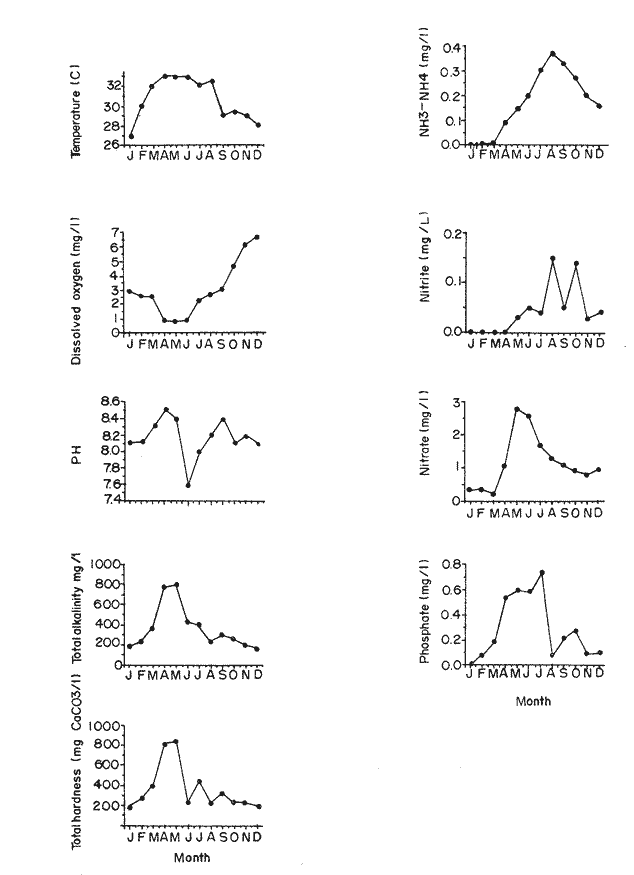 Figure 5. Physicochemical parameters fluctuation along an annual eyele in Uxmal seasonal pond. Limestone quarries: The limestone karst in northern Yucatan has given rise to a large number of limestone-based industries, excavation of limestone for which has resulted in a growing number of under-utilized water-filled quarries. These quarries are filled with groundwater soon after fórmation, because of the shallow water table, which is less than one meter below the surface in most parts of northern Yucatan (Perry et al., 1989). The sizes of these water bodies vary considerably from small ponds of less than one hectare to several hectares. Two studies were carried out on limestone quarries. The first is a small shallow quarry, Sac Be, just 10 km north of Merida. It is an abandoned pit permanently fed by an aquifer and has a total surface area of 0.135 ha (Table 1). This shallow water body is typical of many small ponds in this part of Yucatan and corresponds to the fertilized water body. 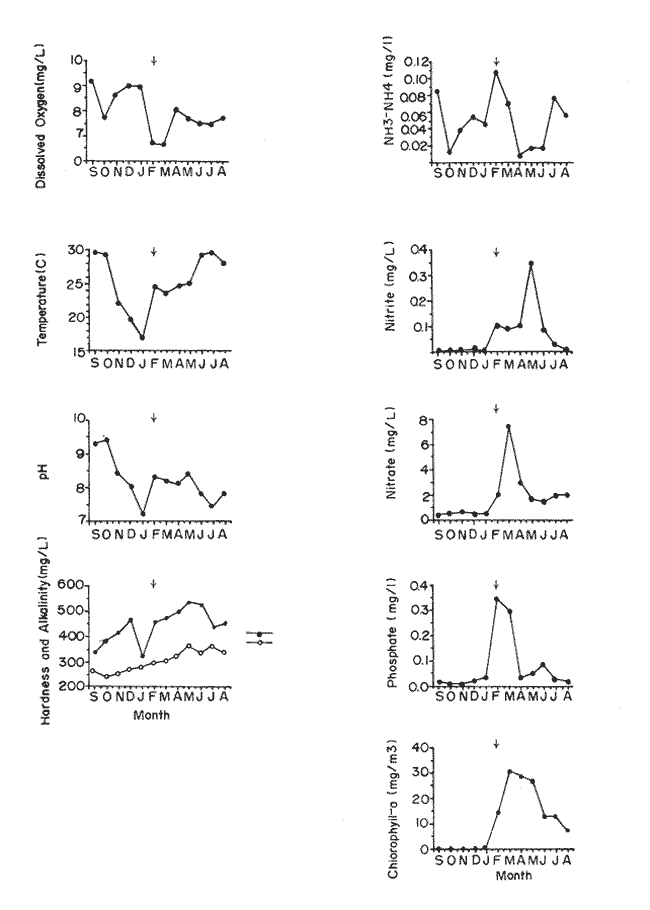 Figure 6. Water quality at Sac-Be gravel quarry during the study period. The arrow indicatees the tinie of fertilization carried out by adding chopped grass Panicum virgatum The second site at Mitza, near Progreso, 30 km north of Merida (Fig. 1), is a larger quarry with a surface area of 9.5 ha (Table 1, Fig. 2). The results of the one-way analysis of variance applied to the data from the four sampling stations established in this quarry, revealed no significant differences among the sets of values for each variable measured (P>0.05), showing a fairly well mixed water body. The results of the survey of Sac Be show some seasonal variation in water quality when undisturbed, with minimum levels of hardness and alkalinity in September and October, at the time of maximum precípitation (Fig. 6). Temperature and dissolved oxygen were high throughout the year (>l7°), with no thermal stratification. Levels of phosphorus and nitrogen were fairly low up until February (<0.05mgPO4/1 and <0.5 mgNO3/1), but increased after February as a result of fertilization of the water with grass (0.4 and 7.6 mg/1 of ortophosphate and nitrate, respectively). This fertilization resulted in a boost in primary production, as measured by chIorophyll a, and both nitrogen and phosphorus, as weIl as pre and post-fertilization algal counts. In both pre and post-fertilization samples, a clear dominance of chlorophytes was observed in the phytoplankton community. The most abundant species were Oscillatoria spp. and Pleodina spp. Two rotifers (Keratella spp. and Brachionus spp.), and the copepod Diaptomus spp. were identi- before fertilization. As a result of fertilization, plankton diversity increased slightly, with six other species being recorded in phytoplankton and three more zooplanktonic species including Daphnia spp., Moina spp. and the copepod Mesocyclops spp. By August 1990, zooplankton diversity had again decreased (Table 2).  Figure 7. Mean temporal fluctuation of physichemical parameters at Mytza gravel quarry. The water in Mytza is also characterized by high pH and relatively high levels of hardness and alkalinity (Fig. 7). Nitrate is relatively high, but the concentration of ammonia, nitrite and dissolved reactive phosphorus is fairly low (<0.08 mg/1). Consequently,the levels of primary productivity, as measured by chIorophyl1 a, are also low (<7 mg/m³ chlorophyll a). Temperature and dissolved oxygen were fairly high throughout the study period, with no significant thermal stratification due to the relatively shallow and exposed nature of the quarry. Zooplankton at Mytza were similar to the species found at Sac Be(Table 2). DISCUSSION
WATER QUALITY AND FISH CULTUREThe results of this survey of water resources serves as a baseline for future limnological studies and for aquaculture plans. A characteristic feature of the water quality at all the study sites was a high pH and high alkalinity and hardness. This feature is a result of dissolution of calcium and magnesium salts from the predominantly limestone geology of the area (Stringfíeld and Le Grand, 1974). The highest levels of hardness were associated with the permanent aguada at X-Pooc and with evaporation and concentration of base salts in Uxmal. The other sites, although high, had lower levels of both hardness and alkalinity, particularly during the rainy season, as a result of direct inputs of rainfall or surface water from the catchment areas. Similar seasonal variations have been noted in other rainfed water bodies (Welcomme, 1979; Arredondo et al., 1982). The pH is an important characteristic of water as far as fish culture is concerned. The optimal range for fish culture is 6.5 - 9.0 (Alabaster and Lloyd, 1982). Comparison with the results of this survey shows that all water bodies fall just within the upper limit, except for the permanent aguada at X-Pooc. The concentration of toxic unionized ammonia will be greater at high pH (Alabaster and Lloyd, 1982). Although pH may not adversely affect fish in these waters, particular care will be required with feeding, fertilization and stocking to ensure that toxic concentrations of animonia are not reached. Alkalinity is also important for fish culture. Recommended levels are 50 - 250 mg/1 as CaCO3 (Alabaster and Lloyd, 1982). The alkalinity of the waters of Yucatan commonly exceeded this upper limit. High alkalinity, though, is not regarded as direct1y toxic to fish but may result, if in excess, in poor primary productivity as a result of carbon dioxide deficiency (King and Garling, 1986). On the other hand, the aquaculuse of oligotrophic systems such as these quarries that: present a high hardness and alkalinity, might have the advantage of minimizing the risks of eutrophication since, under high calcium level waters, a relatively higher input of both nitrogen and phosphorus is needed to actually increase the levels of available nutrients, especially phosphate, to plants due to the reaction Ca-PO4 which chelates the nutrient precipitating it to sediments as Ca2PO4 and making it unavailable to phytoplankton (Wodka et al., 1935). 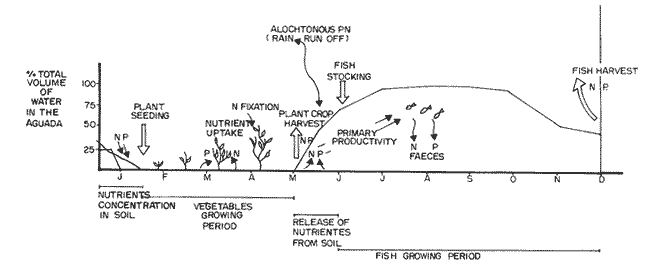 Figure 8. Proposed votational plant/fish culture for seasonal ponds of Southern Yucatan. The nutrient status of the surveyed water bodies varied from the high levels of nitrogen and phosphorus in X-Pooc to the relatively lower levels in the aquifer-fed water bodies, except for a sudden increment induced by organic fertilization in the smaller quarry (Fig. 6). Nitrate was fairly high in all the systems, although there were some seasonal variations associated with rainfall, a result of groundwater infiltration in all but the seasonal aguada. High nitrate is typical of groundwaters (Lesser, 1976), and is not regarded as harinful to fish at the levels recorded. However, high nitrate does indicate potential contamination from organic sources which might be related to domestic or agricultural activities, thus a careful consideration should be given to this parameter. Nitrite and amnionia were present at very toxic levels in X-Pooc, as a result of denitrification processes in the hypolimnion, but were lower in other water bodies. Dissolved reactive phosphorus was highest below the thermocline in X-Pooc where the thermocline probably acts as a physical barrier to the phosphorus being resuspended from the bottom under anoxic conditions, but it was relatively low in the other water bodies. Dissolved reactive pliospliorus is usually regarded as the nutrient limiting the productivity of most static freshwaters (OECD, 1982). An indication of whether pliosphorus is limiting is the ratio of inorganic N to inorganic P, a ratio greater than 10 indicates Pliospliorus is limiting (Chiandani and Vighi, 1974). The ratios for all the water bodies surveyed are greater than 60. Thus it is likely that phosphorus is the nutrient limiting the productivity of phytoplankton in all the water bodies. The low chlorophyll a concentrations in the quarries indicates a relatively low productivity of these water bodies also supporting this hypothesis. The zooplankton in Mytza (Table 2), as in the unfertilized Sac Be pond, are small (adults of the various species measure between 0.5 and 1.5 mm) and scarse, indicating low productivity and intense fish predation. The results of fertilizing Sac Be suggest that the size and abundance of zooplankton can be increased to serve as a more important component of fish diet, in extensive aquaculture. POTENTIAL AQUACULTURE STRATEGIESThere are several ways in which these water bod¡es may be exploited for aquaculture, but water quality will be a major determining factor. In this respect, X-Pooc and similar permanent aguadas are unlikely to be suitable because of the very eutrophic nature of the water, with a high risk of ammonia and hydrogen sulphide toxicity as well as low dissolved oxygen problems. Earlier trials with cage culture of Nile Tilapia (Oreochromis niloticus) in this water bodies have failed because of poor survival, confirming this conclusion. In spite of the high primary productivity. this represents a potential feed source for filter-feeding fish species if favorable conditions could be maintained. Several studies have attempted to improve conditions in stratified autotrophic waters by mixing and aeration of the water column (Bailey Watts et al., 1987). This type of technology could theoretically be used to improve water quality for fish culture, although it is doubtful whether the additional energy cost associated with destratification and mixing would be economically viable. There is also evidence that a well-managed hypertrophic ecosystem can provide an effective fish production system (Belsare, 1986). Fish culture in small hypertrophic water bodies is common in India, where yic1ds as high as 10,000 kg/ha/year of Indian major carps and tilapia are obtained, thus indicating that cultural eutrophication can be reversed by "biological stripping" through high fish harvests (Sreenivasan, 1980). While water quality in the cenote Chen-Ha is suitable for fish culture, the cenotes have a unique flora and fauna showing adaptations to cave life (Reddell, 1977). There is th:us concem for the conservation of these unusual and potentially rare and endemic species. Large permanent cenotes are also often interconnected via aquifers. These aquifers are an important source of potable water throughout Yucatan. Thus, there are a number of uses for the large permanent cenotes that might not be compatible with their use for aquaculture development. thus restricting their potential. The temporary aguadas offer some scope for aquaculture as water qualíty is suitable, although cyclical. Seasonal rotation of aquaculture and agriculture appears to be an ideal approach to the use of such ecosystems. This approach would involve stocking either endogenous or exotic filter-feeding fish species (e.g. Cichlasoma synspilltim or Oreochromis niloticus) in early June, once oxygen levels have stabílized, and harvesting them in December when they have reached market size. Arredondo et al. (1982) found that stocking of 18g tilapia in seasonal pools of central Mexico at 0.8 fish/m² yielded 450 kg/ha, with no supplementary feeding, This approach offers some scope in seasonal ponds of southem Yucatan, thus increasing production by means of additional agricultural crops during the dry season. A schematic representation of this rotational management strategy is present in figure 8. In January, evaporation induces the rapid dissication of the pool thus concentrating nutrients in the bottom. These nutrients are utilized by the crops planted, then in May the plant crop is harvested and as the level of the pool rises rapid1y as a result of the rainfall, juveniles of fish are stocked to take advantage of the natural productivity being established. Fish can then be harvested at market size in December. Alternatively, these areas could be used for pond culture, using especially excavated ponds, where a more intensive management strategy can be imposed. The quarry pools probably offer greatest scope for aquaculture development in Yucatan. These quarries are becoming increasingly comínon in the Yucatan Peninsula as quarrying operations expand. The land used for quarrying is often leased from poor fármers and there is growing concem about how these pools can be used to generate income once quarrying operations cease. Both the small and larger quarries studied on parts of this survey have suitable water quality for aquaculture. The relatively low productivity of the smaller ponds suggested they are unlikely to be suitable without fertilization. The preliminary trial with fertilizer showed some potential for extensive aquaculture for plankton feeders such as tilapia or the endemic species Cichlasoma sinspillum. Both species have proven efficient in aquaculture in the region (Flores-Nava et al., 1989b). Other species of commercial interest include the endemic ornamental poecilids such as Mollinesia vellifera or Xíphophorus sp., which are abundant in karstic features and grow well under hard water conditions.  Figure 9. GIS-constructed map showing the distribution of inland water bodies in the Yucatan Peninsula. The large quarry ponds represent an ideal site for cage culture. Several species may be suitable. Cichlasonia urophthahnus has already been proven as a good candidate for cage aquaculture in terms of growth and food conversion in similar environments in Tabasco, to the west of Yucatan (Flores-Nava et al., 1989a). Nile tilapia (Oreochromis niloticus) can also be cultured in cages and, provided that water quality is maintained, high y¡elds can be expected. An important market for tilapia is expanding in southem United States. Currently, Costa Rica and Honduras produce large quantities of filleted tilapia for the US market. In this sense, Yucatan offers competitive advantages given the closiness to the market. Channel catfish Ictaltirus punctattis may well be another candidate for cage culture in Yucatan's quarries, since it is already being successfully cage-reared in Florida pits, under similar hard water conditions (Conrad, 1988). The combination of caged and ranched fish is another alternative for aquaculture in large gravel quarries, since food from cages is lost through the mesh, and free organisms around the cages can make use of this food., thus providing an extra harvest and minimizing the risks of eutrophication (Beveridge, 1984; Phillips et al., 1985). The objectives of the present work were to preliminarily assess the limnological characteristics of different karstic features, which are representative of Yucatan's freshwater water bodies, and no detailed attempt was made to create an inventary of inland water resources in the region. However, in order to have an overall panorama of the distribution and abundance of the different types of water body present, a map was created using a Geographic Information System (GIS), through the computer-based programme OSUMAP (University of Ohio, 1989), which is presented in Figure 9. The map contains the screening and sorting of 367 water bodies which include sinkholes, clogged sinkholes, quarries, seasonal ponds and lakes, the latter only found in Quintana Roo State to the Southeast of Yucatan. all of which have been visited at least once. From the GIS-constructed map, it was possible to estimate that there exist approximately 400 ha of quarries and 6,500 ha of Seasonal pools, the former on the northem karst plain and the latter south of Sierrita de Ticul range. This provides a basis for further assessments of potential areas for aquaculture development in the Peninsula. Clearly, the water resources in Yucatan do offer some scope for aquaculture, particularly in quarry pools. On the basis of this initial survey of resources, trials are now underway to assess the commercial viability of aquaculture using these pools as a basis for the development of a hither-to non-exístent industry. Conclusiones1. The main and common hydrochernical characteristic of water bodies present in Yucatan is high hardness and alkalinity with high pH, as a result of the calcareous nature of basal rocks. Aquifer-fed water bodies (e.g. quarries and sinkholes) are oligotrophic whilst isolated sinkholes (e.g. permanent aguadas) are hypertophic. 2. Of the five representative water bodies studied in the region, the gravel quarries offer highest potential for aquaculture, with overall good and stable water quality. Small pits could be used for extensive stocking of filter feeding species, but fertilization has to be implemented in order to increase natural productivity. Larger quarries can be managed through more intensive cage-culture, and high y¡elds can be expected. 3. Permanent aguadas present extreme water quality conditions with anoxic hypolimnetic waters, high levels of arnmonia and H2S, which limit fish production. 4. Seasonal ponds present characteristic cyclical physicochemical patterns, imposed by changes in volume. These conditions can be used to implement rotational fish/plant crops culture, and high y¡elds and an efficient use can be expected. AgradecimientosACKNOWLEDGEMENTSI am grateful to D. Valdés for his he1p in hydrochemical analysis and M. Sánchez, who provided field support: for this study. Dr. Stan Dodson (Un¡versity of Wisconsin) kindly provided assitance in identification of plankton. 1 am also indebted to Dr. Michael Phillips (Asian Institute of Technology) for his suggestions and revision of the manuscript. This study was supported by COSNET-México, Project 421/85 and CINVESTAV. LITERATURAALABASTER, J.S. y R. LLOYD Water quality criteriafor freshivaterfish. Butterworth London. 1982 361 p. APHA Standard methodsfor the examination of water and wastewater. American Public Health Association 16th edition Washington, D.C. 1985 1268p. ARREDONDO, F.J.L., J.L. GARCíA y C.A. MARTíNEZ Rev. Latinoam. de Acuac. La conducta físico-química y el rendimiento pesquero de un estanque temporal tropical utilizado para la piscicultura extensiva en el estado de Morelos. 1982 6-13 12 ARREGUÍN, S.F., J.C. SEIJO, D. FUENTES y M. SOLÍS Estado del conocimiento de los recursqs pesqueros de la plataforma continental de Yucatán y región adyacente. Contribuciones de Investigación Pesquera I.N.P. Doc. Tec. 1987 41p. 4 BELSARE, D. K. Tropical fish farming. Environmental Publications. Karad India 1986 160p. BEVERIDGE, M. C. M. Cage and Pen fish jarming. Carrying capacity and environmental impact. FAO Fish. Tec. Pap. 1984 131p. 255 CHIANDANI, G. y M. VIGHI Wal. Res. The N: P ratio and testes with Selenastrum to prediet eutrofication in lakes. 1974 1062-1069 8 FLORES-NAVA, A., D.S. VALDÉS-LOZANO y M. SÁNCHEZCRESPO An. Inst. Cienc. del Mar y Limnol. Comportamiento fisicoquímico de una manifestación cárstica de Yucatán. Universidad Nacional Autónoma de México 1989 223-230 16 (2) FLORES-NAVA, A., M.A. OLVERA y A. GARCíA Aquac. and fish. Mugt. Effects of stocking density on the growth rates of Cichlasoma uroplithalmus Günther in floating cages. 1989a 73-78 20 (1) ---, Aquac. andfish. Mngt. Growth and Feed Conversion of cage-reared Cichlasoma sinspillum. 1989b 173-178 20 (2) HAKANSON, L. Springer A manual on lake morphometry. New York 1981 78p. HEPHER, B. y Y. PRUGININ Commercial fish farming. John-Wiley & Sons New York 1981 261 p. ISOPHORDING, W.C. The physical geology of Yucatan. Trans. Gulf Coast Assoc. Geol. Soc. 1975 231-262 25 KING, D.L. y D.L. GARLING Principles and Practices of Pond Aquaculture. A state of the art overview of aquatic fertility with special reference to the control exerted by chemical and physical factors. pp 53-66. J. Lannan, R.O. Smitherman and A. Tchobanoglous Oregon State University Press 1986 252 p. LESSER. J. M. Estudio hidrogeológico e hidrogeoquímico de la Península de Yucatán. SRH/CONACYT México 1976 63 p. O.E.C.D. Eutrophication of waters. Monitoring assessment and control. Paris OECD 1982 154 p. PARSONS, T.H., Y. MAITA y C.M. LALLI A manual of chemical and biological methods for seawater analysis. Pergamon Press. England 1984 173 p. PERRY, E., J. SWITT, J. GAMBOA, A. REEVE, R. SANBORN, L. MARIN y M. VILLASUSO Geology Geologic and environmental aspects of surface cementation, North coast, Yucatán, México. 1989 818-821 17 PHILLIPS, M.J., M.C. BEVERIDGE y L.G. ROSS Jour. Fish. Biol. The enviromnental impact of salmonid cage culture on inland fisheries. Current status and future trends. 1985 123-137 (suppl. A) PORRAS, D. Biotécnica Acuícola III. Fisicoquímica de embalses. Cuenca oriental Morelos. Univ. Aut. Mor., México. 1985 23p. REDDELL, J.R. Assoc. for Mex. Cave studies. Bulletin 6. Studies on the caves and the cavefauna of the Yucatán Península. The speleo Press. Austin. 1977 296 p. SREENIVASAN, A. Hipertrophic ecosystems. Fish production in some hypertrophic ecosystems in South India. J. Barica and L.R. Mur Developments in Hydrobiology 2. Junk. London 1980 pp 273-277 STRICKLAND, J.D.H. y T.R. PARSONS Bulletin 167 A Practical Handbook of Seawater Analysis Fisheries Research Board of Canada. (Second Edition) 1972 310 pp. STRINGHELD, V.T. y H.E. LEGRAND Field Seminar on water and Carbonate Rocks of the Yucatan Péninsula, Mexico. Karst hydrology of the northem Yucatan Peninsula, Mexico A. Weidie New Orleans Geological Society. 1974 pp. 25-44. TURNER, B. L. Biótica Agricultura intensiva en las tierras bajas mayas: una lección del pasado 1980 69-79 5 (2) UNIVERSITY OF OHIO OSUMAP for the PC. Manual. Geographic Information Systems Lab. Dept. of Geography. OSU Columbus Ohio USA 1989 WELCOMME, R. L. Fisheries ecology offloodplain rivers. Longinan Group LTI) London 1979 317 p. WODKA, M.C., S.W. EFFLER y C.T. DRISCOLL Limnol. and Oceanog. Phosphorus Deposition from the epilimnion of Ondonaga Lake. 1985 833-843 30 (4)
|

